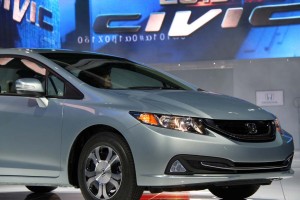
The 2013 Honda Civic update adds rollover airbags to the car's electronic stability control technology.
Breakthrough technology designed to prevent vehicle rollovers and other serious accidents has saved an estimated 2,200 lives over the last three years, according to the nation’s top vehicle safety regulator.
A federal rule mandating the use of electronic stability control was enacted in April 2007 and following a four-year phase-in, every vehicle sold since September 1, 2011 has had to use the technology which is often known as ESC, ESP or electronic stability program.
The technology is intended to help vehicles avoid skids and other accidents and has proven particularly effective at preventing rollovers, the government indicates.
“NHTSA research has consistently shown ESC systems are especially effective in helping a driver maintain vehicle control and avoid some of the most dangerous types of crashes on the highway, including deadly vehicle rollover situations or in keeping drivers from completely running off the roadway,” said Administrator David Strickland of the National Highway Traffic Safety Administration.
As many as 10,000 Americans die in rollover crashes annually, even though rollovers occur in just 3% of highway accidents.
Electronic stability control uses many of the same basic components of the less complex anti-lock brakes, or ABS, technology. Sensors detect when a vehicle is in danger of skidding or otherwise losing control and can then apply brakes and take other steps – such as reducing engine speed – to help the driver maintain control.
Calling it a clear message, U.S. Department of Transportation Secretary Ray LaHood promised that the the number of fatalities ESC has already prevented will grow.
“As more vehicles on the road are equipped with ESC in the coming years, we know the technology will save even more lives,” he suggested.
NHTSA has estimated that stability control systems could ultimately reduce the number of rollover accidents by 84% once the technology becomes effectively ubiquitous in the American automotive fleet, reducing fatalities by as much as 5,300 to 9,600 deaths annually.
However, the roll-out process could take a decade or more to complete considering that the average vehicle on the road today is at least a decade old and registration data show that 20% are older than 16 years, Toyota’s U.S. chief executive Jim Lentz noted during a keynote speech at the 2012 LA Auto Show.
Stability control is just one of a growing number of technologies designed to both prevent rollovers and, if necessary, help reduce the risk of injury or death if one occurs. Honda, for example, announced its update 2013 Civic model will come with an advanced airbag system, dubbed SmartVent, designed to deploy during rollovers,
(For more on the new 2013 Honda Civic and its safety technology, Click Here.)
While electronic stability control systems were first offered as a $1,500 to $2,000 option after the technology was introduced in the early 1990s, NHTSA now estimates it costs only about $111 to add the feature on top of a conventional ABS system. Proponents say that cost is more than offset by the reduction in crashes and the lowered risk of injury and death.
